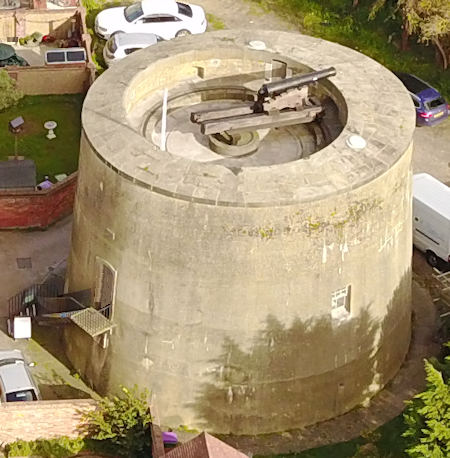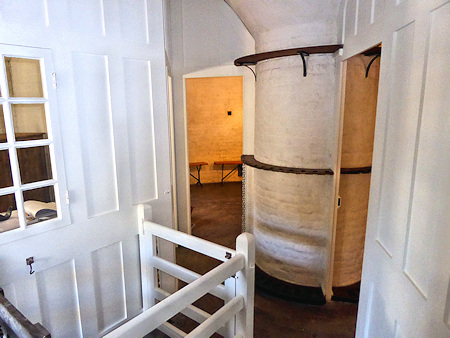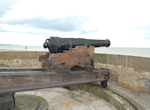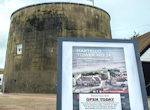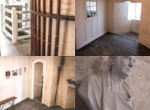Martello Tower No. 24
Martello Tower No. 24 in Dymchurch High Street was one of 74 towers built along
the south coast of England between 1805 and 1812, to resist the threatened French invasion.
74 Martello Towers were built on the Kent and Sussex coast, with Martello Tower No.24 considered to be the best surviving example, being closest to its original condition and it can be seen as it was when occupied by the military in 1806.
The tower has been restored to its original design and layout with almost all of the original tower still in place. Martello Tower No.24 is only one of 3 of the 74 built that is open to the public.
The tower contains almost all of the features of the original design including brickwork, front and parapet doors, window openings, fireplaces, ventilation shafts, the original 24 pounder muzzle-loading cannon on the gun platform, parapet shot lockers, hauling rings, replica gunpowder barrels, and replica 'Brown Bess' muskets.


About the Tower
![]() Introduction
Introduction
![]() Historical Description
Historical Description
![]() Inside the Tower
Inside the Tower
![]() Plan of the Tower
Plan of the Tower
![]() Displays in the Tower
Displays in the Tower
![]() What Happened to the Tower?
What Happened to the Tower?
![]() Pictorial Tour of Martello24
Pictorial Tour of Martello24
![]() Martello24 Reference Material
Martello24 Reference Material
![]() Conservation Repairs 2019
Conservation Repairs 2019
Martello24 Photos
![]() Photo Galleries
Photo Galleries
![]() Pictorial Tour of Martello24
Pictorial Tour of Martello24
![]() Model of Martello24
Model of Martello24
Martello24 Reference Material
![]() England Heritage Guide to Martello Tower No. 24
England Heritage Guide to Martello Tower No. 24
![]() Tour of Martello Tower No.24
Tour of Martello Tower No.24
![]() Video of Martello Tower No. 24
Video of Martello Tower No. 24
![]() 3D Virtual Historic Tour of a Martello Tower
3D Virtual Historic Tour of a Martello Tower
![]() Illustrated Leaflet about Martello Towers
Illustrated Leaflet about Martello Towers
![]() Martello Tower No.24 Reference Material
Martello Tower No.24 Reference Material
![]() 'Brown Bess' Musket
'Brown Bess' Musket
![]() Loading and Firing a ‘Brown Bess’ Musket
Loading and Firing a ‘Brown Bess’ Musket
![]() Video Showing the Loading and Firing of a Flintlock Musket
Video Showing the Loading and Firing of a Flintlock Musket
![]() History of the term ‘Brown Bess’
History of the term ‘Brown Bess’
You can find out more here.

Dymchurch Martello Tower No. 24 is an example of a specialised type of coastal fortifications erected during the Napoleonic Wars to repel a feared invasion by France.
In 1804 French troops were known to be mustering at Boulogne, just 29 miles away, with the object of crossing the English Channel. Plans were made to place towers along likely invasion areas in Suffolk, Essex, Kent, and East Sussex.
Their tactical purpose was described by the Quartermaster General's Department in their plans of 1803:
The advantage proposed by these towers is to keep possession of the defences to the annoyance of the enemy during the whole operation of his landing, and the probable prevention of his disembarking stores; and either to oblige his bringing artillery against them when he has landed or leaving us in possession of the bay or anchorage which they protect - would enable us to intercept all supplies which he might endeavour to follow the Armament.
Find out more at Origins and Purpose of the Martellos
The Tower - Historical Description
The tower was made of about half a million bricks, and although the tower looks round, it is in fact slightly elliptical, which helped to deflect incoming cannon fire.
The walls were thicker on the side facing the sea because that was where most enemy fire was expected to come from. The roundness and thickness of the walls were designed to deflect cannonballs, which tests proved they could not penetrate.
A round brick pillar rose through the center of the tower to support the roof, on which a cannon on a rotating gun carriage could fire in all directions.
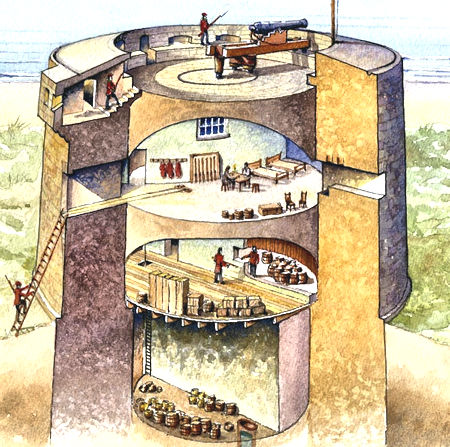
Artists impression of a Martello Tower (larger picture)
The gun platform was on the top. Dymchurch tower reveals all the features of the original design. The basement was for storing ammunition, fuel, and provisions and these supplies were separated from each other by wooden partitions. In addition, the gunpowder barrels were placed in a specially ventilated recess.
The design of the bomb-proof towers was inspired by a fort in the Bay of Mortella in Corsica which had beaten off two British warships in 1794. The strength of such towers had been dramatically demonstrated when a fleet under Lord Hood had been sent to capture Corsica. Crucial to the British attack was the capture of a stone watch-tower on Mortella Point.
This tower was armed with one 6-pounder and two 18-pounder guns by the French and it successfully repulsed an attack by HMS Fortitude (74 guns) and HMS Juno (32 guns), both of which withdrew with serious damage and some sixty casualties.
By 1812 there were 74 such towers sited on the South Coast and a further 29 in Suffolk and Essex.
Some of them were placed in pairs to protect the gates of marsh sluices. Tower 24 at Dymchurch and its counterpart no 25 (now largely derelict) was an example of the latter type.
The design of the towers was simple with the seaward walls thicker than those to landward. A single entrance was placed at the first-floor level approached by a removable ladder. The only windows were small and high, facing inland.
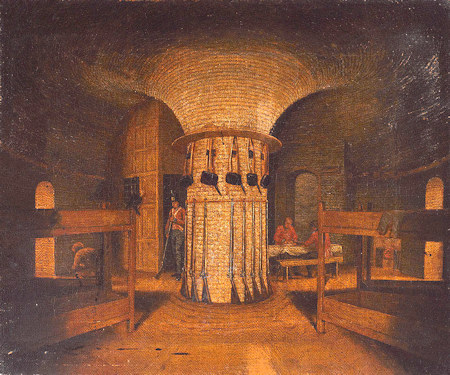
The interior of a Martello Tower 1812
(Oil on canvas by Captain William Ford, Royal Engineers)
The gunpowder was stored on the ground floor in a specially designed area with ventilation ducts, to keep the gunpowder dry, and double skinned walls. The risk of fire and/or explosion was minimised by protecting the necessary lantern with a glass plate.
The first floor contained quarters for both officers and en although it is apparent that the full complement of 24 would have been very cramped. Inside the entrance is a vestibule with a trap-door to the basement; above the trap, a metal ring in the vault was used for a rope for hauling stores up from below. Immediately in front of the entrance is the central brick column supporting the vault; around the column is a rack that once held flintlock muskets, the main weapon of the British army from the 1730s to the 1830s.
The muskets here would probably have been the cheaper `India Pattern' type, made in large numbers by the East India Company for its own armies, but purchased by the Board of Ordnance to supplement its own production and purchases of the famous 'Brown Bess' muskets.
Find out more about 'Brown Bess' muskets
The main armament of Martello Tower No.24 was a 24 pounder smooth-bore muzzle-loading gun mounted on a carriage capable of traversing 360 degrees. The cannon is characterized by a longer barrel, larger propelling charges, smaller shells, higher velocities, and flatter trajectories. The 24 pounder cannon on the gun platform of the Tower was a typical cannon of the time, used both by the Army and on the Royal Naval ships.
The cannon weighed some 2½ tons, which could be turned through 360 degrees with the aid of ropes. It was worked by a team of 10 to 14 men using step-boards along each side. Such a gun could fire a solid or explosive round shot for over a mile.
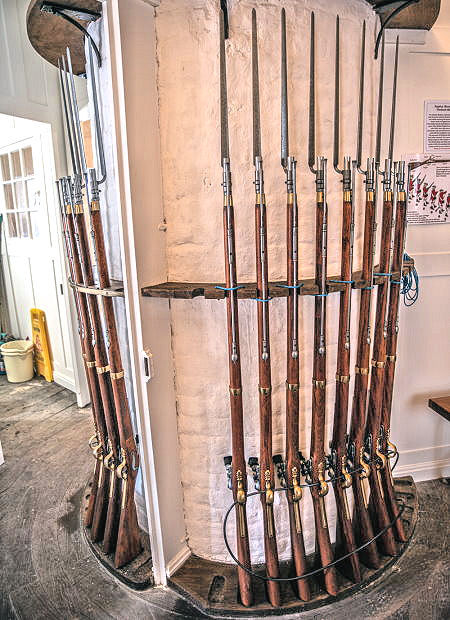
'Brown Bess' Muskets in their rack on the first floor
The ingenuity of the design of Martello Towers was never put to the test since Nelson's defeat of the French fleet at Trafalgar in 1805 and Napoleon's decision to invade Russia removed the possibility of a French invasion.
Martello Tower No.24 is a Scheduled Ancient Monument and a Grade II Listed Building.
For more detailed information, please see:
![]() Tour of Martello Tower No.24
Tour of Martello Tower No.24
![]() Description of Martello Tower No. 24
Description of Martello Tower No. 24
![]() Loading and Firing a Cannon
Loading and Firing a Cannon
With the end of the war with Napoleon in 1815, many of the Martello Towers were abandoned by the military but a renewed threat from France in 1830 and again in 1859 led to some of the towers being rearmed and then abandoned again.
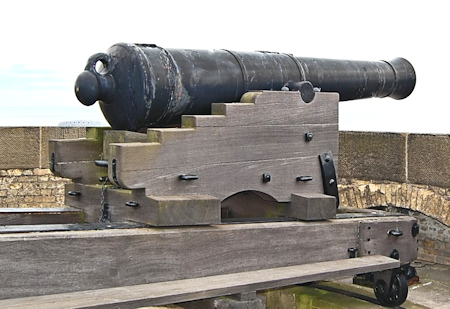
24 Pounder Cannon on the roof
With many of the other towers, Martello Tower No.24 was first used as a signal station. Then, from about 1819/20, it was taken over by the newly formed Royal Naval Coast Blockade Service in the 'war' against smuggling on Romney Marsh. As a Blockade Station, it was the headquarters to naval personnel comprising 1 Mate, 2 Petty Officers and 9 men. Some of them may have had their wives living with them.
In 1831 the Coast Blockade was absorbed into The Coastguard Service, which came into operation in 1822 and the Coastguard continued to use the tower, together with their families, until sometime between 1881 and 1891.
The census for 1891, 1901 and 1911 show no one living in Tower No.24. The Tower in 1881 is listed as a coastguard station with 4 men and their families living there, so between 1881 and 1891 it would appear the people were transferred to the coastguard cottages in Dymchurch.
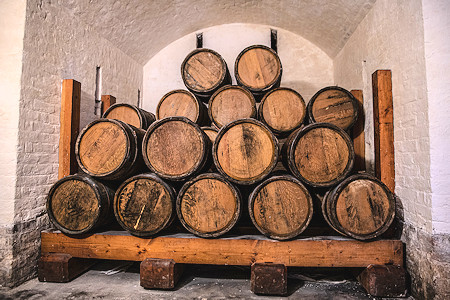
Gunpowder Store on Ground Floor
During the Second World War, it was used to spot incoming aircraft and the V1 & V2 flying bombs. It was manned for a time by a Forward Observation party from 64 Field Regiment, RA based in the Dymchurch and New Romney area,
It was left unused until 1959 when the tower was acquired from the War Office by the Ministry of Works. when it was no longer required by the Coastguard. It was restored to its original state and opened to visitors as a museum in 1969. Today it is in the care of English Heritage and opens to visitors at weekends during the summer months.
Sir Walter Scott, the Scottish historical novelist, playwright and poet, described Martello Towers in the first chapter of his novel "Peveril of the Peak":
...built ... in such a fashion as if he had intended it, as an Irishman said of the Martello Towers, for the sole purpose of puzzling posterity
Martello Tower No. 24 is located in Dymchurch, just off the High Street. The tower is open to the public by the Friends of Martello 24 every
Saturday from 2 pm to 4 pm
Easter to end of October 2024
When the tower is not open, bespoke visits by appointment are available for recognised groups eg History Societies, WI Schools, Scouts & Girl Guides etc, comprising of more than 10 people.
![]() Location Map & Directions High Street, Dymchurch TN29 0NU
Location Map & Directions High Street, Dymchurch TN29 0NU
![]() what3words.com/zipped.mows.bench
what3words.com/zipped.mows.bench

Plan of a typical Martello Tower Find out more
Entry to the tower is free but as a charity, the Friends of Martello24 are dependent on donations and these are always appreciated.
NB Access to the tower is by a metal staircase to the first floor, and once inside, access to the roof/gun platform and to the ground floor is by very steep stairs. Thus the tower is not particularly suitable for people with mobility problems (see pictures ). There are no facilities inside the tower.
Outside of the public opening hours, bespoke visits by appointment are available for recognised groups comprising of more than 10 people eg History Societies, WI, Schools, Scouts & Girl Guides etc. Find out more
If your group would like to arrange a visit, please contact the Friends of Martello24 via ![]() RomneyMarshHistoryUK@gmail.com
RomneyMarshHistoryUK@gmail.com
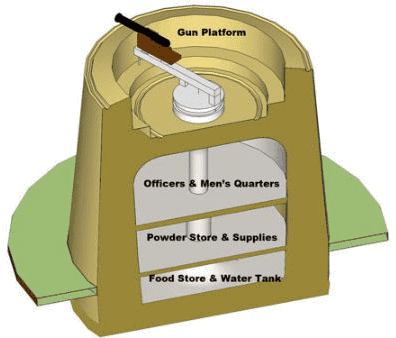
Section through a Martello Tower
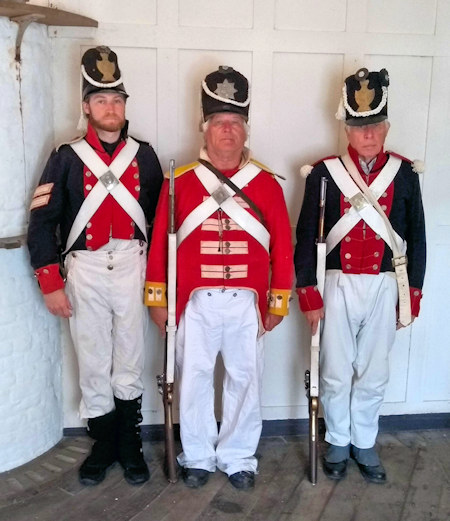
Cinque Ports Volunteers
Soldiers of the period who would have manned the towers
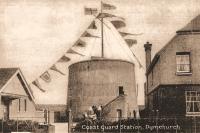
Celebrating the end of WW1
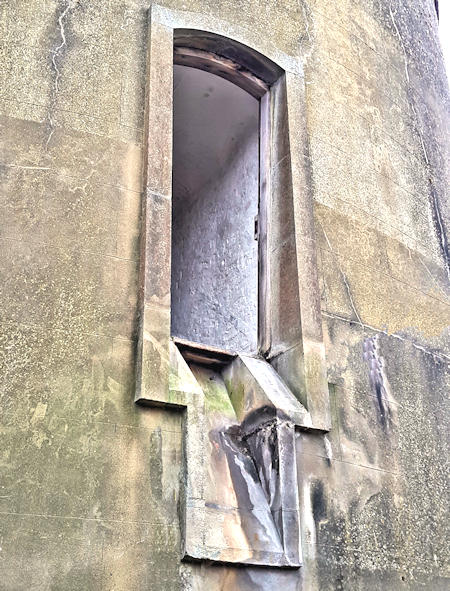
First Floor Entrance with Ladder Chute
(as it would have been when built)
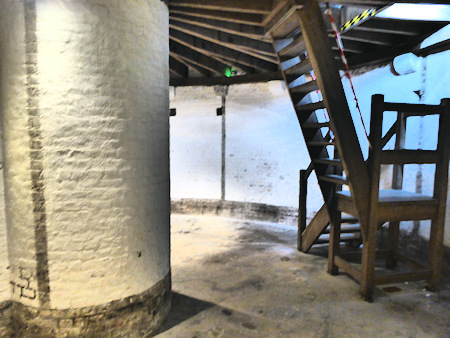
Part of the Ground Floor
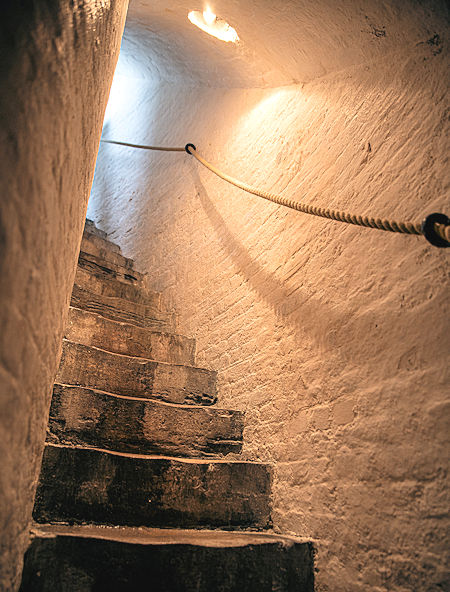
Stairs to the Roof
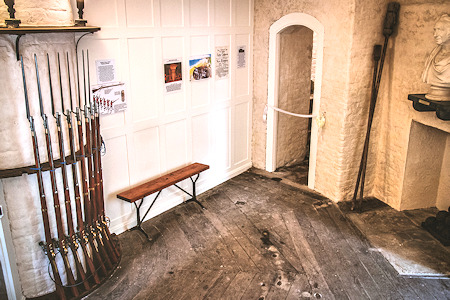
First Floor Soldiers Room
Friends of Martello24 has been set up as a charitable organisation to work with English Heritage to open Martello Tower No 24 to the public on a published regular basis.
Find out more




